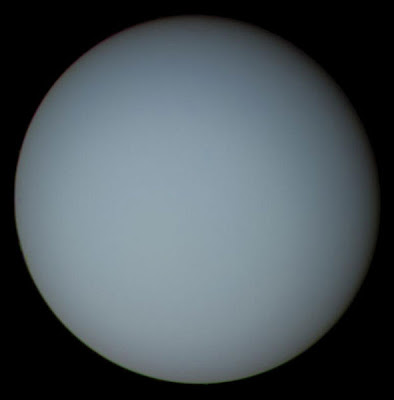Uranus / Urano

Uranus is the seventh planet from the Sun and the third largest. The main feature of Uranus is the inclination of its axis almost ninety degrees with respect to its orbit, an inclination which is not only limited to the same planet, but its rings, satellites and magnetic field. Uranus has the most uniform surface of all the planets by their characteristic blue-green color produced by the combination of gases in its atmosphere. Although at first glance it may not seem, it has a system of rings, including one blue. It is also a gaseous planet. As happens with Venus, Uranus has a retrograde motion, turning clockwise. The planet has an atmosphere formed by a mixture of hydrogen and helium and traces of methane (being about 15% of its planetary mass) and the mantle would be formed by ice and chemical oceans, water, ammonia and methane, providing a high electrical conductivity. Uranus has 27 known moons, Titania and Oberon being the largest with a similar size (1580 and 1520 km in diameter, respectively). It takes 84 years to circle the sun and a diameter of 50,724 km.
_______________________
Urano es el séptimo planeta del Sistema Solar y el tercero en tamaño. La principal característica de Urano es la inclinación de su eje de rotación de casi noventa grados con respecto a su órbita; una inclinación que no sólo se limita al mismo planeta, sino también a sus anillos, satélites y campo magnético. Urano posee la superficie más uniforme de todos los planetas por su característico color azul-verdoso, producido por la combinación de gases presentes en su atmósfera y aunque a simple vista no lo parezca, tiene un sistema de anillos, incluido uno azul. Es también un planeta gaseoso. Igual que pasa con Venus, Urano tiene un movimiento retrógrado, girando como las agujas del reloj. El planeta cuenta con una atmósfera formada por una mezcla de hidrógeno y helio y trazos de metano que representa aproximadamente un 15% de la masa planetaria, el manto estaría formado por hielos y océanos de compuestos químicos, agua, amoníaco y metano, dotándolo de una alta conductividad eléctrica. Urano tiene 27 satélites naturales conocidos, siendo Titania y Oberón los más grandes con un tamaño muy similar 1580 y 1520 km de diámetro, respectivamente. Tarda 84 años en dar la vuelta al sol y su diámetro es de 50.724 km.
_______________________
Urano es el séptimo planeta del Sistema Solar y el tercero en tamaño. La principal característica de Urano es la inclinación de su eje de rotación de casi noventa grados con respecto a su órbita; una inclinación que no sólo se limita al mismo planeta, sino también a sus anillos, satélites y campo magnético. Urano posee la superficie más uniforme de todos los planetas por su característico color azul-verdoso, producido por la combinación de gases presentes en su atmósfera y aunque a simple vista no lo parezca, tiene un sistema de anillos, incluido uno azul. Es también un planeta gaseoso. Igual que pasa con Venus, Urano tiene un movimiento retrógrado, girando como las agujas del reloj. El planeta cuenta con una atmósfera formada por una mezcla de hidrógeno y helio y trazos de metano que representa aproximadamente un 15% de la masa planetaria, el manto estaría formado por hielos y océanos de compuestos químicos, agua, amoníaco y metano, dotándolo de una alta conductividad eléctrica. Urano tiene 27 satélites naturales conocidos, siendo Titania y Oberón los más grandes con un tamaño muy similar 1580 y 1520 km de diámetro, respectivamente. Tarda 84 años en dar la vuelta al sol y su diámetro es de 50.724 km.



Comentarios
Publicar un comentario